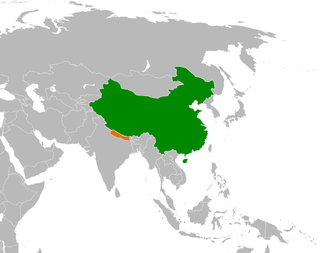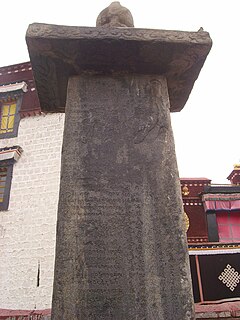Related Research Articles
The foreign relations of Tibet are documented from the 7th century onward, when Buddhism was introduced by missionaries from India. The Tibetan Empire fought with Tang China for control over territory dozens of times, despite peace marriage twice. Tibet was conquered by the Mongol Empire and that changed its internal system of government, introducing the Dalai Lamas, as well as subjecting Tibet to foreign hegemony under the Yuan Dynasty. Tibetan foreign relations during the Ming Dynasty are opaque, with Tibet being either a tributary state or under full Chinese sovereignty. But by the 18th century, the Qing Dynasty indisputably made Tibet a subject. In the early 20th century, after a successful invasion, Britain established a trading relationship with Tibet and was permitted limited diplomatic access to "Outer Tibet", basically Shigatse and Lhasa. Britain supported Tibetan autonomy under the 13th Dalai Lama but did not contest Chinese suzerainty; while "Inner Tibet", areas such as Amdo and Kham with mixed Chinese and Tibetan populations to the east and north, remained nominally under the control of the Republic of China although that control was seldom effective. Though the sovereignty of Tibet was unrecognized, Tibet was courted in unofficial visits from Nazi Germany, Imperial Japan, and the United States during and after World War II. The foreign relations of Tibet ended with the Seventeen Point Agreement that formalized Chinese sovereignty over most all of political Tibet in 1951.

The Jokhang, also known as the Qoikang Monastery, Jokang, Jokhang Temple, Jokhang Monastery and Zuglagkang, is a Buddhist temple in Barkhor Square in Lhasa, the capital city of Tibet. Tibetans, in general, consider this temple as the most sacred and important temple in Tibet. The temple is currently maintained by the Gelug school, but they accept worshipers from all sects of Buddhism. The temple's architectural style is a mixture of Indian vihara design, Tibetan and Nepalese design.
Bayanchur Qaghan — was second qaghan of Uyghur Khaganate. His Tang dynasty invested title was Yingwu Weiyuan Pijia Qaghan or simply Yingwu Qaghan. He was also known as Gelei Qaghan. His official regnal name in Turkic was Tengrida Bolmish El Etmish Bilge Qaghan. He is mostly famous for ordering erection of Tariat Inscriptions.

The Uyghur Khaganate (or Uyghur Empire or Uighur Khaganate, self defined as Toquz-Oghuz country, was a Turkic empire that existed for about a century between the mid 8th and 9th centuries. They were a tribal confederation under the Orkhon Uyghur nobility, referred to by the Chinese as the Jiu Xing, a calque of the name Toquz Oghuz or Toquz Tughluq. Its capital was Ötüken and later Ordu-Baliq. It was succeeded by Yenisei Kyrgyz Khaganate.
The first military conflict between China and Tibet occurred in 638. In the early 7th century, the westward conquests of the Chinese Tang dynasty brought it into contact with the rising Tibetan Empire. When Emperor Taizong of Tang refused a marriage alliance, the Tibetan emperor Songtsen Gampo sent an army to attack the Chinese frontier city of Songzhou. After a Tang army inflicted heavy casualties on the Tibetans in a night-time attack, Songtsen Gampo withdrew. He sent emissaries and tributes to Chang'an to apologize, and to again request marriage. Taizong decided to give Songtsen Gampo a distant niece, Princess Wencheng, in marriage. The peace held for the remainder of the reigns of Taizong and Songtsen Gampo, although Tibet would pose major military threats for most of the rest of the Tang period.
Ralpacan, born Tritsuk Detsen c. 806 CE according to traditional sources, was the 41st King of Tibet, ruling from the death of his father, Sadnalegs, in c. 815, until 838 CE. He is referred to as "son of God" in the Testament of Ba.

The bilateral relation between Nepal and China has been friendly and is defined by the Sino-Nepalese Treaty of Peace and Friendship signed on April 28, 1960 by the two countries. Though initially unenthusiastic, Nepal has been of late making efforts to increase trade and connectivity with China. Relations between Nepal and China got a boost when both countries solved all border disputes along the China–Nepal border by signing the Sino-Nepal boundary agreement on March 21, 1960 making Nepal the first neighboring country of China to agree to and ratify a border treaty with China. The government of both Nepal and China ratified the border agreement treaty on October 5, 1961. From 1975 onward, Nepal has maintained a policy of balancing the competing influence of China and Nepal's southern neighbor India, the only two neighbors of the Himalayan country after the accession of the Kingdom of Sikkim into India in 1975. In recent years, China has been making an effort to gain entry into SAARC, and, Nepal has continuously backed and supported the proposal to include China as a member in the regional grouping. Since 1975, Sino-Nepalese relations have been close and grown significantly, though India remains the largest source of Foreign direct investment (FDI), and the largest source of remittance after Qatar. Based on the amount of remittance to Nepal sent by Nepalese migrants working in India, the government of Nepal estimate that there are around 1 million Nepalese migrant workers in India while the number of Nepalis in China is minuscule as of 2017.
Tibet is a term for the major elevated plateau in Central Asia, north of the Himalayas. It is today mostly under the sovereignty of the People's Republic of China, primarily administered as the Tibet Autonomous Region besides adjacent parts of Qinghai, Gansu, Yunnan, and Sichuan.

The Tibetan Empire existed from the 7th to 9th centuries AD when Tibet was unified as a large and powerful empire, and ruled an area considerably larger than the Tibetan Plateau, stretching to parts of East Asia, Central Asia and South Asia.

The Tang dynasty in Inner Asia was the expansion of the Tang dynasty's realm in Inner Asia in the 7th and, to a lesser degree, the 8th century AD, in the Tarim Basin, across the Gobi Desert and into Middle Asia. Wars were fought against the Gokturk Empires and Xueyantuo, but also against the states of the Tarim basin. This expansion was not steady; for example, the Tang did lose control of the Tarim basin temporarily to the Tibetans in the 680s, and their expansion north of the Gobi was thwarted in 682. Emperor Taizong's military success was, in part, a consequence of changes he initiated in the Chinese army, including improved weaponry. The emperor placed a new emphasis on cavalry, which was very important because his non-Chinese opponents used the horse effectively in warfare.

During Tang dynasty rule in China (618–907), Chinese and Tibetan forces had many battles, although there were also years of peace.

Tibet under Yuan rule refers to the Yuan dynasty's rule over Tibet from approximately 1270 to 1354. During the Yuan rule of Tibet, the region was structurally, militarily and administratively controlled by the Mongol-led Yuan dynasty of China, a division of the Mongol Empire. In the history of Tibet, Mongol rule was established after Sakya Pandita got power in Tibet from the Mongols in 1244, following the 1240 Mongol conquest of Tibet led by the Mongol general with the title doord darkhan. It is also called the Sakya dynasty after the favored Sakya school of Tibetan Buddhism.
Nganlam Takdra Lukhong, also known as Nganlam Tara Lukhong, Nganlam Lukhong or Lon Takdra, was a famous general of the Tibetan Empire who served as Lönchen during Trisong Detsen's reign. In many Chinese records, his name is given as Mǎ Chóngyīng.

This article elaborates on the historical relationship development between imperial China and Tibetan regime in Tang and Song dynasty. For detailed information of the history of Tibetan regime, see Tibetan regime.

The Tang-Tibetan Treaty Inscription is a stone pillar standing outside the Jokhang temple in Lhasa, Tibet. The inscription is written in both Tibetan and Classical Chinese, concerning the treaty between the Tibetan Empire and Tang Empire in A.D. 821/823. Amy Heller's book Tibetan Art describes it as one of the most important treaties between the Tang and Tibet.
Bögü Qaghan or Tengri Qaghan — Third khagan of Uyghurs. He was the younger son of Bayanchur Khagan. His personal name was Yaoluoge Yidijian (藥羅葛移地健) and was titled Ulu Bilge Töles Shad during his father's reign. His subsequent regnal names upon inheriting the throne was Tarkhan Bögü Qaghan, Alp Külüg Bögü Qaghan and finally Tengrida Qut Bolmish El Tutmish Alp Külüg Bilge Qaghan. He was posthumously renamed as Kün Tengrida Qut Bolmish El Tutmish Alp Külüg Bilge Qaghan by Baoyi Qaghan, stressing his adoption of Manichean religion. Another titles granted to him were Yingyi Qaghan (英義可汗) - a Tang dynasty invested title and Zahag-i Mani - a Manichaean title.
Baoyi Qaghan was the eighth ruler of Uyghurs. His personal name is not known, therefore he is often referred as his Tang dynasty invested title Baoyi which was invested on 22 June 808.
Chongde Qaghan was the ninth ruler of Uyghurs. His personal name is not known, therefore he is often referred as his Tang dynasty invested title Chongde which was invested on 26 May 821.
Yang Liangyao was a Tang dynasty eunuch official known only from his tomb stele, discovered in 1984. He had a long and distinguished career at the Tang court, and led a number of embassies, most notably to the Abbasid Caliphate in 785.

The Peace treaty between China and Tibet, also called the Sino-Tibetan Peace Treaty of 783 or Treaty of Qingshui is a peace treaty negotiated in 783 between the Chinese Empire of the Tang Dynasty, ruled by Emperor Dezong and the Tibetan Empire ruled by Trisong Detsen, giving the latter all the land in the Kokonor region which corresponds to present-day Qinghai Lake. The treaty is celebrated in Qingshui, and was the sixth treaty between China and Tibet.
References
- ↑ Beckwith, Christopher I. The Tibetan empire in central Asia : a history of the struggle for great power among Tibetans, Turks, Arabs, and Chinese during the early Middle Ages (First paperback ed.). Princeton, New Jersey. ISBN 978-0-691-21630-0. OCLC 655804720.
- ↑ Walter, Michael L. (2009). Buddhism and empire: the political and religious culture of early Tibet. Leiden: Brill. ISBN 978-90-474-2928-9. OCLC 712986501.
- ↑ 李方桂, Fang-Kuei Li (1956). "The Inscription of the Sino-Tibetan Treaty of 821-822". T'oung Pao. 44 (1/3): 1–99. ISSN 0082-5433.